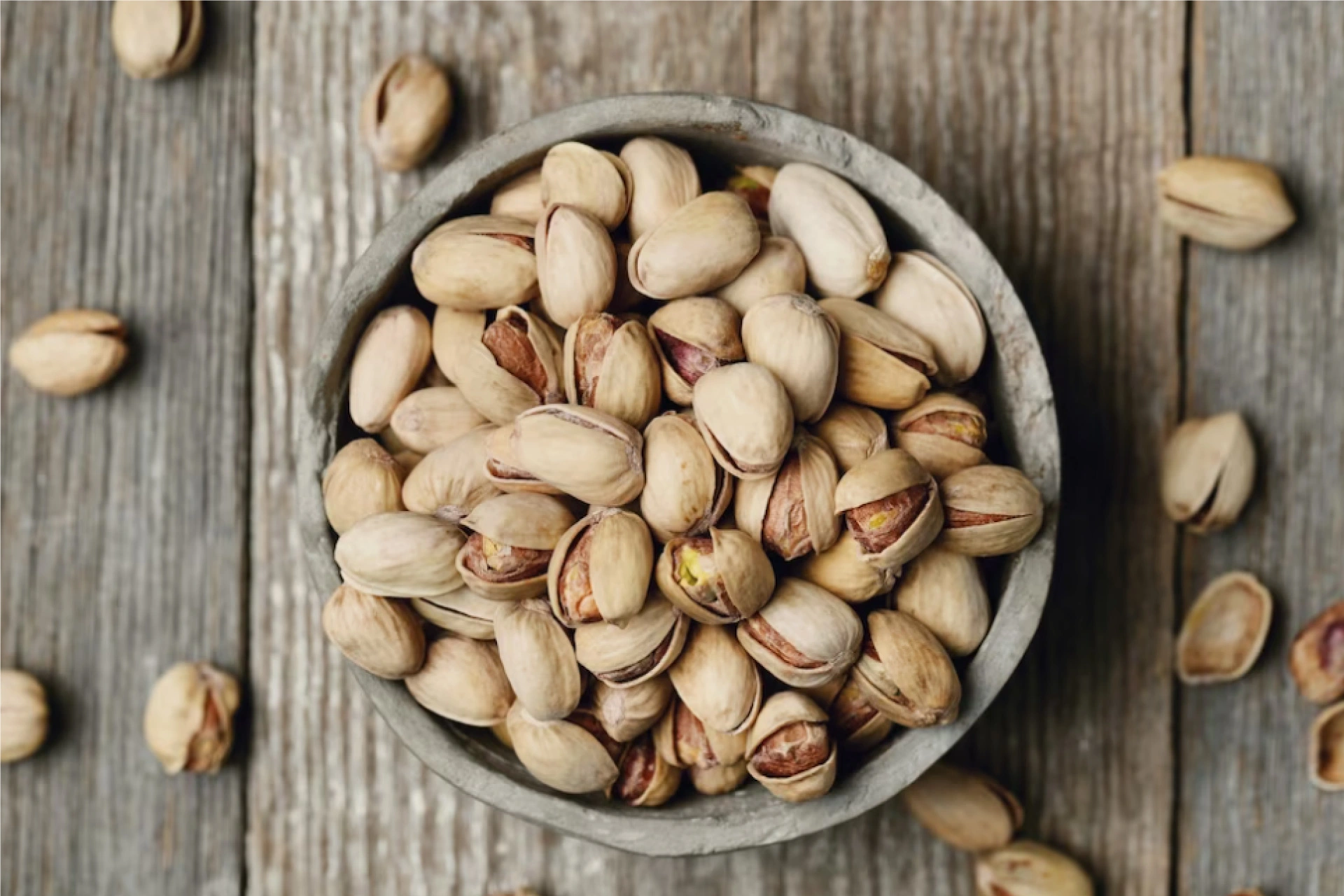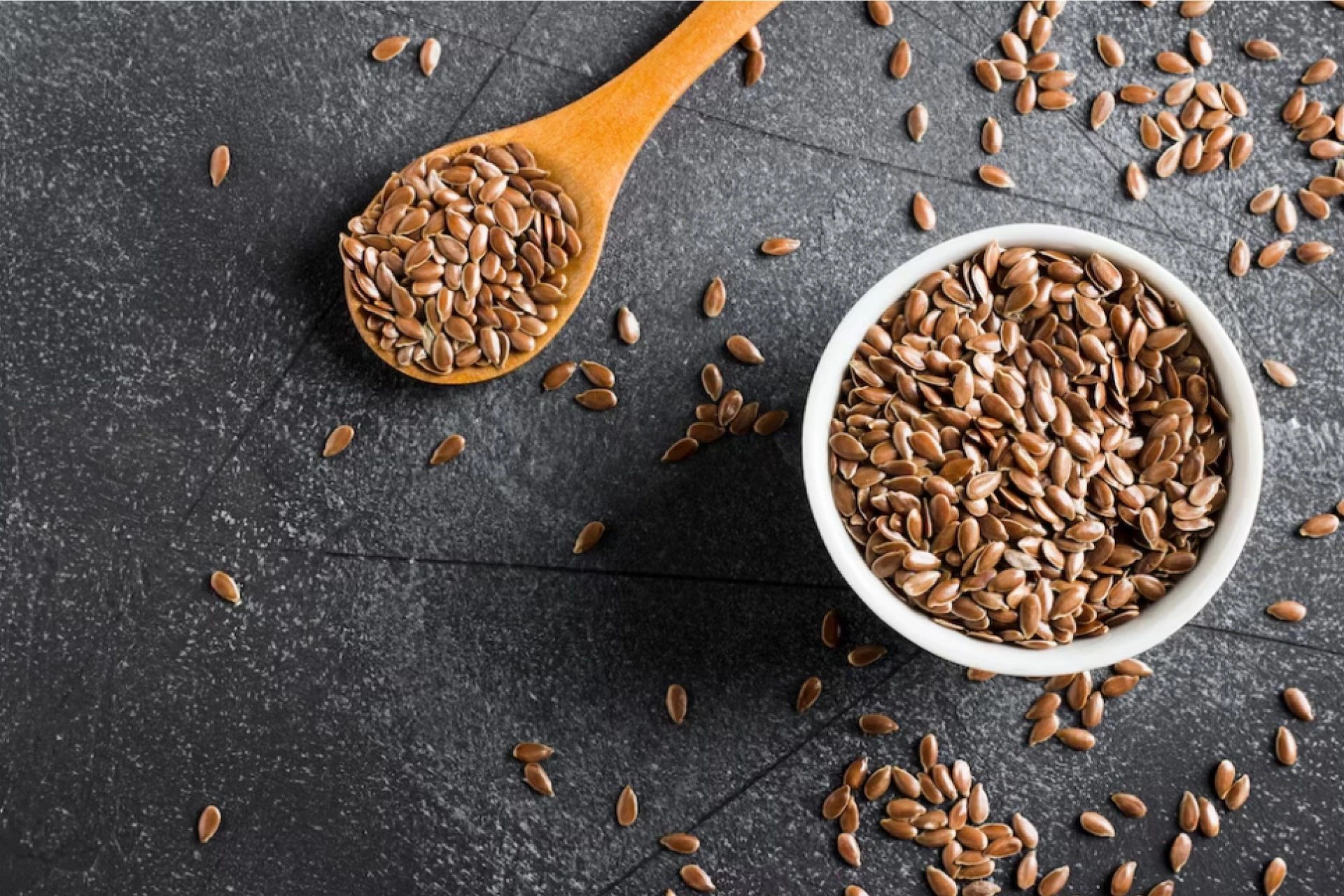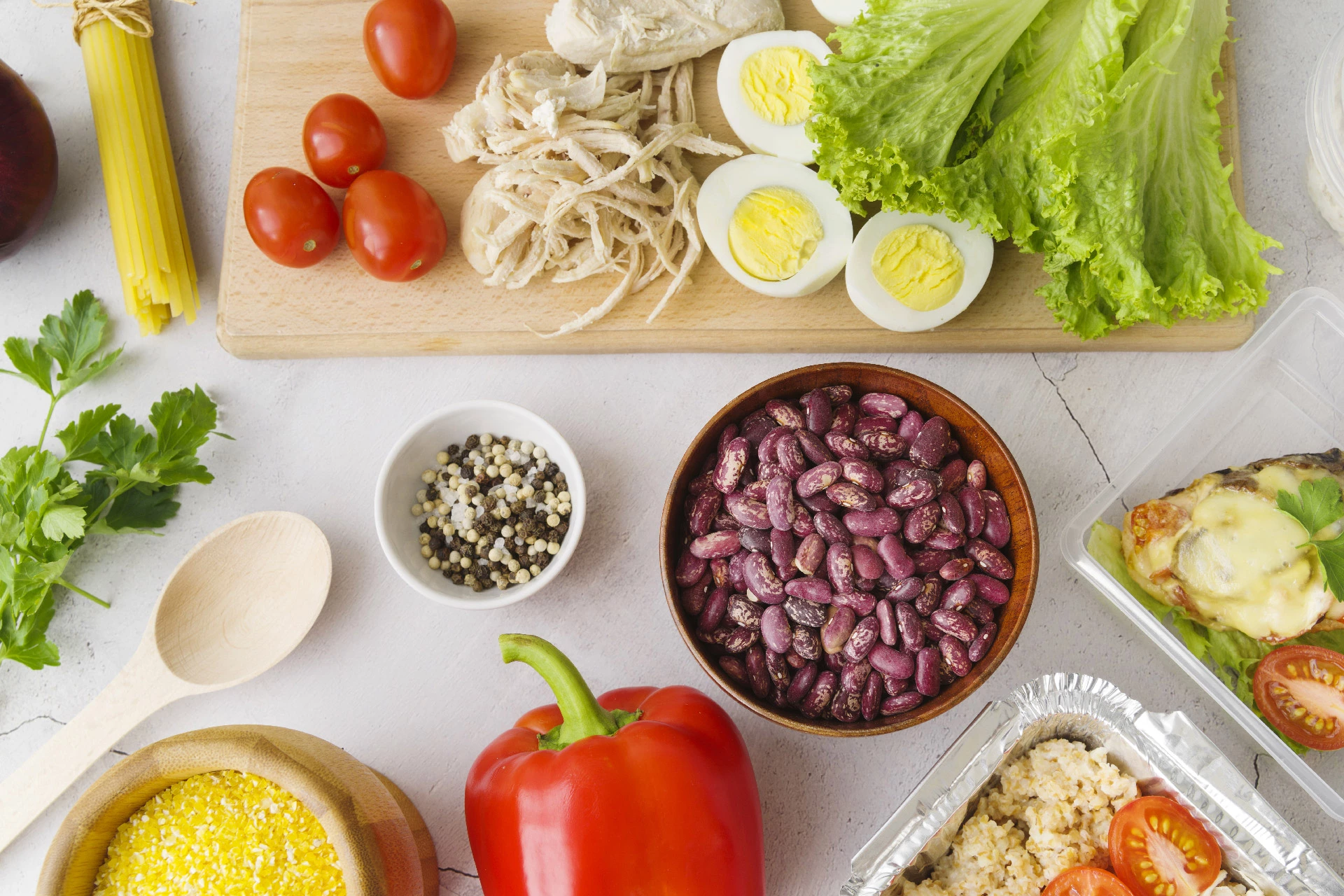Nutrition | 5 min read
All about Candida Diet Plan: 6 FAQs on Candida Cleanse Diet
Medically reviewed by
Table of Content
Key Takeaways
- Asparagus and broccoli are parts of the Candida diet food list
- A Candida diet plan may not include certain types of animal proteins
- Fruits like apples can be a part of the Candida diet breakfast
Candida is a yeast that leads to Candidiasis, a fungal infection [1]. Few species of Candida Candida cause infection in people. This type of yeast normally lives on the skin and inside your body without causing problems. Only if it grows out of control or enters deep into your body can it cause infection [2]. This fungus can affect different parts of your body but is commonly found in
- Mouth
- Nose
- Ears
- Toenails
- Fingernails
- Gastrointestinal tract
- Genitals
The Candida diet plan is a meal plan used to help your body overcome Candidiasis or Candida overgrowth. Generally, Candida's diet plan consists of leafy green vegetables, low-sugar fruits, and gluten-free foods. It is also recommended to avoid alcohol.
The Candida diet aims at reducing fungal infection and preventing the overgrowth of yeast, but it has many other benefits. This diet helps keep your gut healthy and boosts your immunity. There are various kinds of Candida Candida cleanses diets you can follow. Take a look at Candida's diet recipes available on the internet to get started. Read on to understand more about the Candida diet plan and its benefits.
What is the Candida Diet?
Candida is defined by the Centre for Disease Control (CDC) as a yeast or fungus that lives on the skin and inside places such as the mouth, throat, toenails, gut, vagina, and rectum. [1] Candida is usually thought to be innocuous and does not create any problems. A surplus of Candida can result in a fungal infection known as candidiasis.
According to research, over a hundred known Candida species exist in various body areas. These Candida species aid our bodies in digestion and nutrient absorption. [2] It also helps with digestive health. Although many Candida species exist in our bodies, just fifteen are known to cause illness, such as Candida albicans.
Some attribute many common symptoms to an overgrowth of the fungus-like organism Candida albicans in the intestines. For example, this fungus causes weariness, headaches, and poor memory. This illness is also known as yeast syndrome.
Some people use a candida-cleanse diet to treat these symptoms. Sugar, white flour, yeast, and cheese are all eliminated from the normal diet. The Candida cleanses diet is based on the idea that these foods promote candida growth.
Even though several studies and research have been given to support the symptoms, risk factors, and effects of candida overgrowth, therapies are inconsistent and insufficient. [3] The candida diet, which is said to reduce and treat infections, is one possible therapeutic option.
The candida diet plan is normally indicated to be followed for a short period of time in consultation with health experts and not as a replacement for medical therapies provided by competent healthcare professionals and medical practitioners.
How does the Candida Diet work?
To combat Candida overgrowth and Candidiasis, a candida diet is recommended. Sugar, gluten, alcohol, certain dairy products, and toxic additives are all avoided in this diet, emphasizing low-sugar fruits, non-starchy vegetables, and gluten-free foods. These dietary limitations are based on the idea that avoiding particular foods and beverages may reduce the likelihood of Candida overgrowth in the body.
Candida is assumed to be ubiquitous in the human gut, often known as the digestive tract. Candida overgrowth can worsen intestinal conditions like ulcerative colitis and existing Crohn's disease.
The diet emphasizes eating clean foods, including proteins, gluten-free grains, healthy fats, non-starchy vegetables, and probiotics. These foods are intended to reduce inflammation and stabilize yeast levels in the gut. Although these food limits are based on dubious studies, the candida diet is primarily based on the following principles:
- The candida diet removes gluten due to beliefs that gluten consumption can harm the lining of the intestines
- High sugar consumption is also thought to worsen candida infections, especially in people with compromised immune systems
- Similarly, a high-carbohydrate diet is thought to boost candida numbers in some people and is thus avoided in this diet
- Certain dairy products are also prohibited from this diet since they are thought to promote candida growth by increasing acidity in the mouth and decreasing pH levels in the digestive tract
- Other foods, notably those containing artificial additives, coloring, preservatives, and pesticides, are strictly prohibited
- To promote clean eating and good lifestyle habits, as well as to avoid cheat meals, alcohol and caffeine are also prohibited
Before embarking on the strict candida diet, proponents recommend starting with a candida diet cleanse. The candida diet is a short-term diet designed to cleanse your body, ease the strain on your digestive tract, and eliminate toxins. The key to sticking to this diet is to start slowly and focus on removing food items one at a time rather than stopping abruptly.
Is the Candida Diet healthy?
There is no definitive research or verified ideas to back up the candida diet's effectiveness. However, despite a dearth of studies, the candida diet is pretty nutritious. Unlike many fad diets, the candida diet is likely to be safe for most people to follow.
However, there is limited evidence that dietary adjustments can mitigate the symptoms of substantial yeast overgrowth. Doctors typically use antifungal medications to treat yeast overgrowth. [4] By doing an endoscopy (a procedure that involves inserting a small scope into your stomach) and taking a small sample of your stomach lining (a biopsy), this overgrowth is identified.
There isn't much evidence to back up the diagnosis of yeast syndrome. Furthermore, no clinical trials have been conducted to demonstrate that a candida cleanse diet is effective in treating any known medical problem.
On the other side, and not unexpectedly, many people may observe that their health improves when they follow this candida diet. Most processed foods are eliminated if you quit consuming sugar and white flour. These foods are typically higher in calories and poorer in nutritional content. There is mounting evidence that eating whole foods and avoiding processed foods may provide health benefits that are unrelated to yeast overgrowth.
You may begin to feel better in general after a few weeks of replacing processed foods with fresh ones and white flour with whole grains. However, rather than preventing yeast development, the main benefit of a candida diet is that it cleanses the body and is likely to improve your mood.
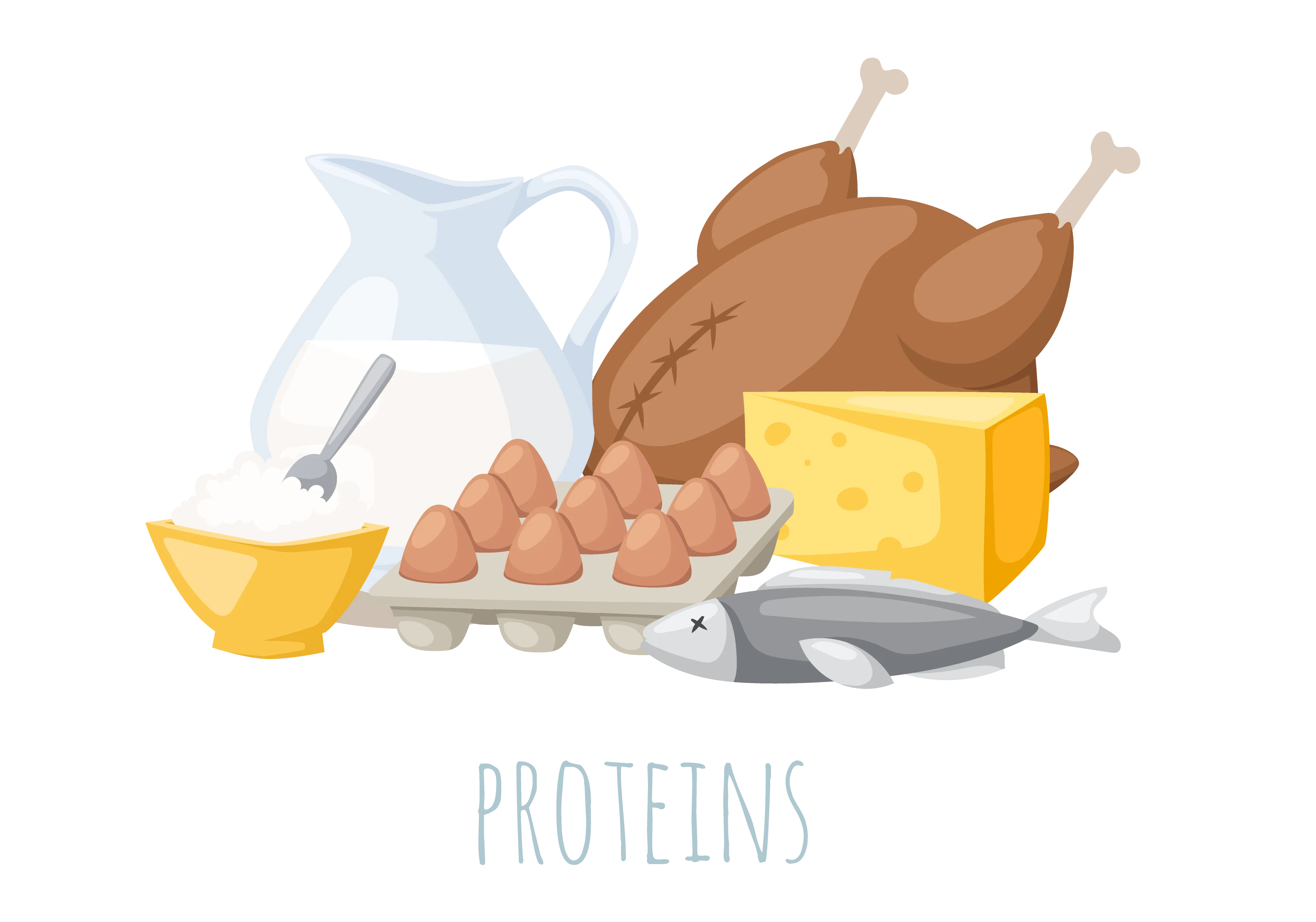
Candida diet plan
Before starting a Candida diet plan, it is recommended to go on a cleanse to prepare your body. Candida cleanses diet usually lasts for a few days and consists of either only liquids or only vegetables with some protein. The Candida Candida cleanse diet will help release toxins and stress. After completing the cleanse diet, you can start the Candida diet plan. To get you started, here is what you should and should not eat.
Which foods are part of the Candida Diet?
Here is a list of foods to eat when on a Candida cleanse:
- Vegetables that are not starchy – Artichokes, Asparagus, Brussels sprouts, Broccoli, Cauliflower, Celery, Cucumber, Garlic (Raw), Kale, Rutabaga, Spinach
- Fruits with low sugar content- Avocado, Olives
- Proteins that are good for you
- Several dairy products
- Nuts and seeds that are resistant to mould
- Herbs, spices, and sauces
- Fats and oils that are healthy for you
- Natural sweeteners include fruits like stevia and monk fruit.
- Foods that have been fermented
- Chicory coffee and herbal teas are examples of beverages.
- Wild Fish
- Gluten-free grains and protein-rich foods such as quinoa, buckwheat, millet, eggs, salmon, and chicken
- Fruits with low sugar such as berries, lemon, lime, kiwi, grapefruits, and watermelon
- Steamed or raw non-starchy vegetables like cabbage, broccoli, eggplant, zucchini, onion, and tomatoes
- Spices and herbs such as salt, ginger, garlic, turmeric, thyme, paprika, black pepper, and cinnamon
- Dairy and healthy fat foods like olives, avocados, flax oil, olive oil, unrefined coconut oil, ghee, yogurt, or butter
- Caffeine free drinks like filter water, coconut milk, herbal teas, lime or lemon-infused water, or almond milk
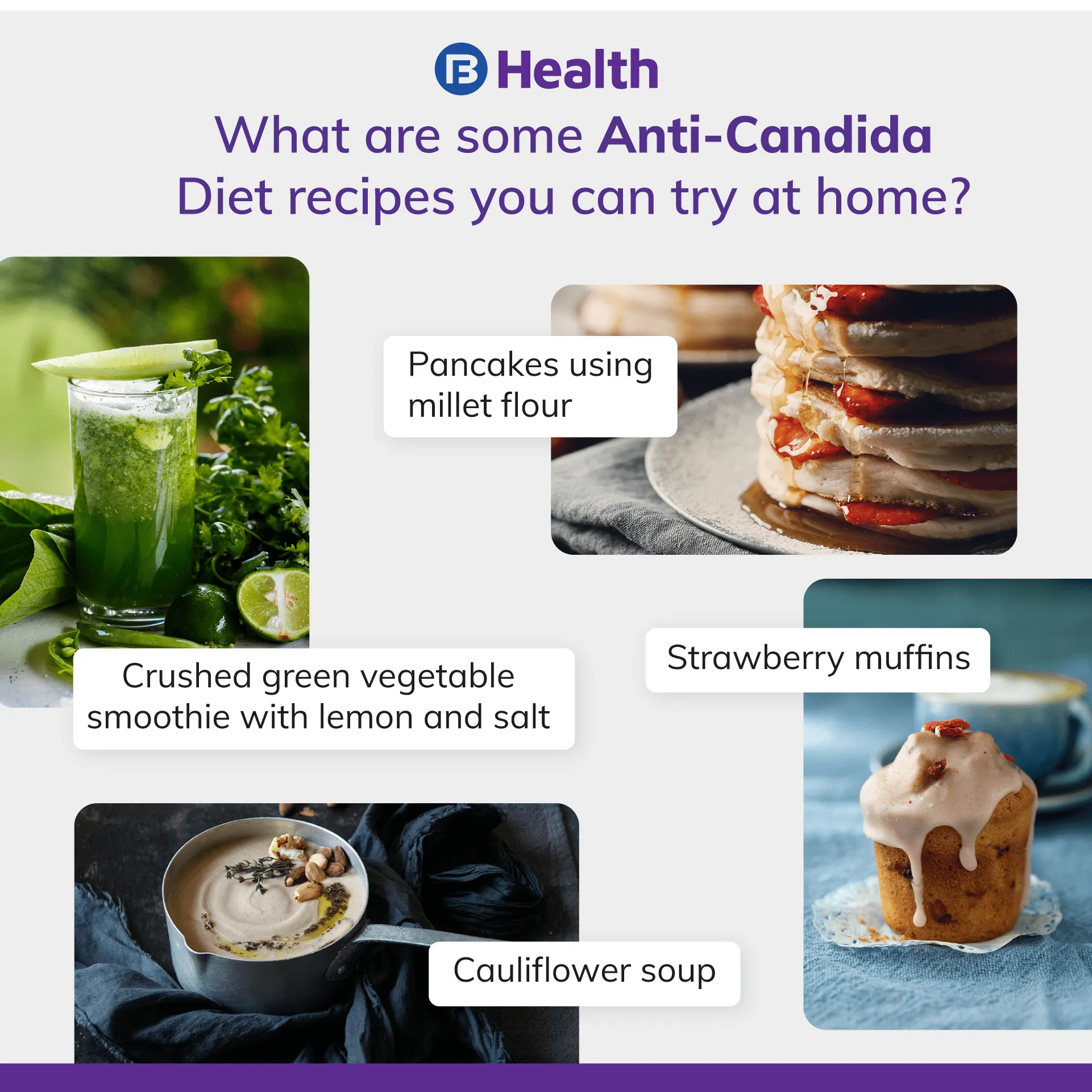
Candida diet foods to avoid
Certain dairy products, alcohol, sugar, and gluten can lead to Candida overgrowth. As a result, when you go on a Candida diet plan, you need to follow a strict plan that excludes these fruits. To make things easier, here is a list of foods that you should avoid.
- Barley, wheat, rye, couscous, semolina, and corn foods are some common gluten-rich foods.
- Oils produced from canola, soya bean, margarine, and sunflower are highly refined, contain processed fats, and should be avoided.
- Grapes, mangoes, dates, raisins, bananas, figs, guavas, and pomegranates are high fruits that contain high levels of sugar. This is why they should not be a part of your Candida diet plan.
- Beverages that contain high amounts of sugar, alcohol, and caffeine should be excluded from the Candida diet plan. Some common examples of these beverages are soda, coffee, energy drinks, fruit juices, wine, or beer.
A 7-Day Sample Meal Plan for the Candida Diet
Day 1
Breakfast: Sautéed eggs and spinach in coconut oil
Lunch: A bed of greens with shredded turkey breast and a lemon-olive oil vinaigrette
Dinner: Roasted cauliflower, zucchini, and salmon
Day 2
Breakfast: Frittata with cherry tomatoes, asparagus, and avocado on top
Lunch: Collard greens swaddled with creamy chicken salad prepared with avocado
Dinner: Vegetable and steak kebabs
Day 3
Breakfast: Chia pudding with berries and sunflower nuts on top.
Lunch: Olive oil-dressed kale salad with sliced almonds, roasted vegetables, and olives
Dinner: Meatballs served with pasta sauce over zucchini noodles.
Day 4
Breakfast: Berries and pancakes that are anti-candida approved.
Lunch: A slice of vegan frittata, spinach salad, and sliced avocado
Dinner: Spicy almond-butter sauce coated crudités and chicken satay.
Day 5
Breakfast: Smoothie made with berries, nut butter, coconut oil, and non-dairy milk.
Lunch: Tuna Niçoise salad
Dinner: Roast chicken with skin, peppers, onions, and auberge sautéed
Day 6
Breakfast: Vegetables and an egg scramble.
Lunch: Dark leafy green salad with chicken soup as a side.
Dinner: Tomato sauce-topped zucchini boats filled with ground turkey.
Day 7
Breakfast: An omelets with avocado and salsa
Lunch: Cherry tomatoes and sautéed broccoli served with turkey patties as a side.
Dinner: Cod baked with carrots and green beans
Common questions about Candida diet plan
What is the ideal breakfast for Candida's diet?
A Candida diet for breakfast doesn't need to be complex at all. Ingredients like eggs and yogurt are very nutritious, high in protein, and can form the core of your meal.
What bread can I eat on the Candida diet?
Do not consume whole grain and refined bread containing wheat. Instead, you can eat whole grain bread prepared from recommended gluten-free grains, such as millet flour or rice.
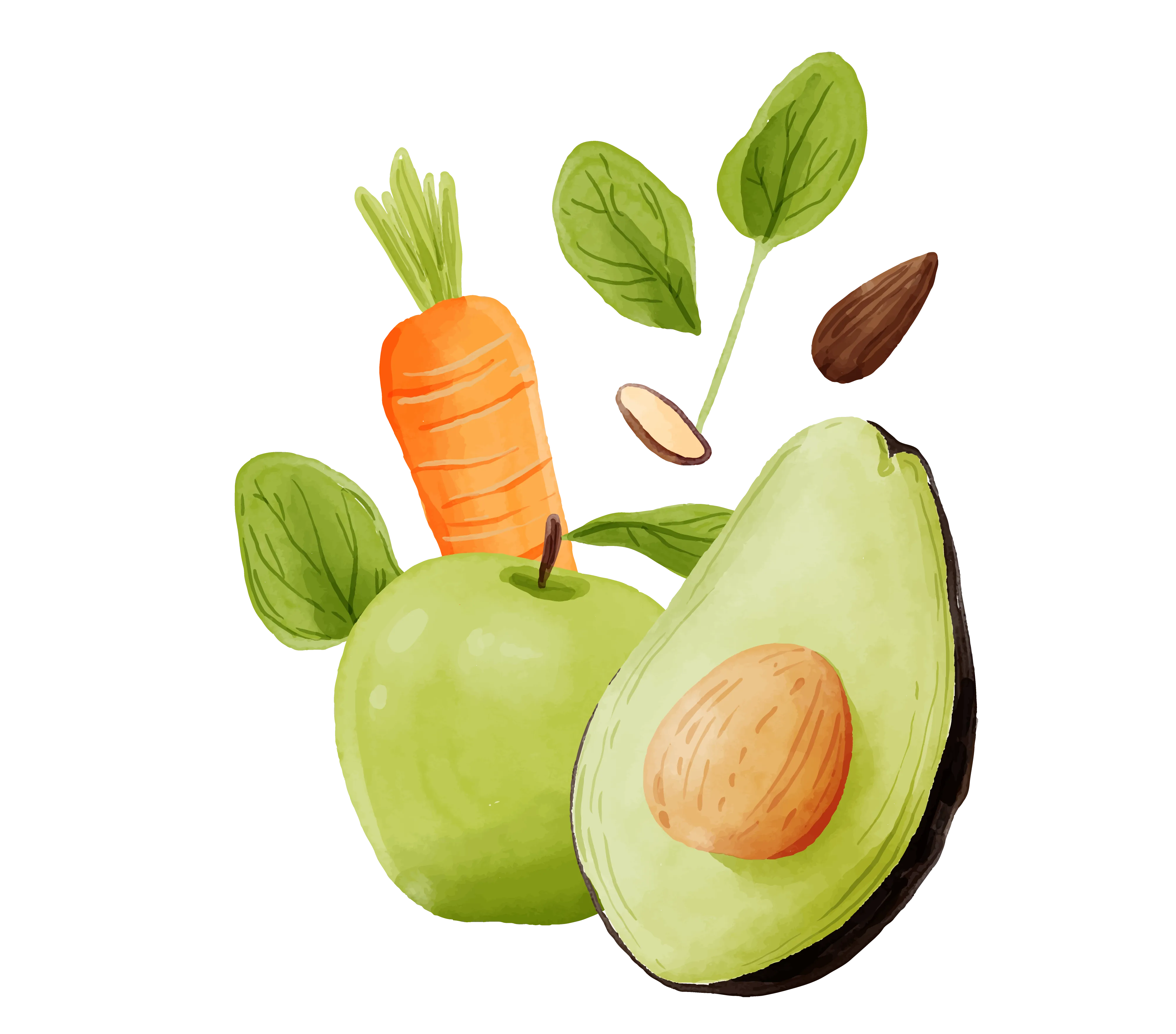
Can you eat rice on the Candida diet?
Rice is a gluten-free grain and can be consumed as a part of your diet. But if you want a detailed explanation, you can consult a doctor.
Can you eat yogurt on the Candida diet?
Yogurt is packed with probiotic bacteria, so it is okay to consume yogurt while you are on a Candida diet. Make sure to consume yogurt without added sugar.
Are there any Candida diet snacks?
There are many recipes that you can follow to prepare a Candida diet snack. Some easy snacks that you can try are as follows.
- Curried cauliflower soup
- Baba ghanoush
- Zucchini pesto bread
- Are there any Candida diet desserts?
Most Candida diets require you to eliminate carbs and sugars, but with a few recipes like strawberry muffins, lemon coconut cookies, or blueberry panna cotta, you can eat Candida desserts. Make sure to take advice from your doctor before trying any of these recipes at home.
Additional Read: Benefits of GheeWhat are the benefits of a Candida Diet plan?
The anti-Candida diet isn't about decreasing weight, unlike most other diets. Instead, it focuses on enhancing your health. The following are the benefits of this diet:
- Restores a healthy microbial balance
- Restores immune function
- Helps with digestion
- It can decrease inflammation
- It improves mood and helps you feel better
- It deals with brain and emotional problems and aches and pains
- Promotes healthy gut
- Helps restore immune function
- Aids in improving digestion
- Reduces inflammation
- Restores overall health
Foods to Avoid on a Candida Diet
Some things to stay away from when following a candida diet are listed below.
Sugars and harmful sugar alternatives: You must stay away from foods like honey, molasses, white sugar, cane sugar, maple syrup, etc. if you're on a Candida diet
Fruits High in Sugar: Mangoes, grapes, and other fruits with a lot of sugar should all be avoided. Additionally, avoid dates, raisins, and fruit juices
Mouldy Seeds & Nuts: Avoid consuming nuts like pistachios, cashews, and peanuts, as well as butter prepared from them.
Adornments: The candida diet advises against consuming mayonnaise, barbeque sauce, soy sauce, ketchup, and white vinegar
Grains High in Gluten: Barley, wheat, rye, and other grains high in gluten should not be consumed
Processed fats and refined oils: On this diet, you should avoid canola oil, soybean oil, margarine, butter spreads, and sunflower oil
Processed fish and meat: Processed meats and seafood should be avoided, including swordfish, tuna, and shellfish
Caffeinated beverages: Avoid drinking coffee and black tea
Alcoholic or sweetened beverages: Avoid drinking alcohol, including wine, beer, liquor, diet or regular soda, and energy drinks
Potential Disadvantages of the Candida Diet
You can survive without refined grains and sugar, and there is little risk associated with consuming the foods on this diet. There's a significant probability that you'll feel terrific if your diet before was primarily made up of processed junk food. For instance, increasing your fibre and water intake may, among other things, assist in controlling your bowel movements.
However, some experts are worried. According to Tamara Duker Freuman, RD, CDCES, the New York City-based author of The Bloated Belly Whisperer, on this kind of low-carb diet, a variety of people with symptoms (attributable to candida) would feel better. Still, she was not sure it was because of candida. The difficulty is that a wide range of health issues are
Following the Candida diet, a meal plan helps overcome the fungal infection known as the Candida overgrowth diet. It can also help your body by promoting gut health and improving overall health. There are various Candida diet symptoms you can keep an eye out for, like nausea or vomiting. Be aware of what to eat and what CandidaCandida diet foods to avoid. A particular diet may work on somebody else and not you, so take advice from a specialist. Book an online doctor consultation on Bajaj Finserv Health to get an idea about these diet plans.
References
- https://www.cdc.gov/fungal/diseases/candidiasis/index.html
- https://www.ncbi.nlm.nih.gov/books/NBK2486/
- https://rarediseases.org/rare-diseases/candidiasis/
- https://www.ncbi.nlm.nih.gov/pmc/articles/PMC3654610/
- https://www.ncbi.nlm.nih.gov/pmc/articles/PMC6352194/
- https://www.ncbi.nlm.nih.gov/pmc/articles/PMC4725385/
- https://www.thebloatedbellywhisperer.com/
Disclaimer
Please note that this article is solely meant for informational purposes and Bajaj Finserv Health Limited (“BFHL”) does not shoulder any responsibility of the views/advice/information expressed/given by the writer/reviewer/originator. This article should not be considered as a substitute for any medical advice, diagnosis or treatment. Always consult with your trusted physician/qualified healthcare professional to evaluate your medical condition. The above article has been reviewed by a qualified doctor and BFHL is not responsible for any damages for any information or services provided by any third party.

